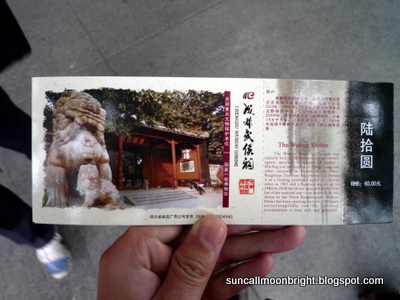View the previous post here or return to the trip index here.
30 May 2009
Woke up early and after a hurried breakfast, we took a cab to Wuhou Shrine (武侯祠, Wu Huo Ci). Wuhou meaning the Marquis of War refering to Zhuge Liang. The site is originally build during the Tang dynasty and is dedicated to Zhuge Liang, Liu Bei's famed strategist during the Three Kingdoms Era. However it also is the site of Liu Bei's burial grounds. Now it contains many stuctures as will as figures of famous Shu-Han generals. Beside Wuhou Shrine is Jin Li (锦里) street, an ancient street of old houses now hosting a variety of local shops and eateries.

Main Entrance of Wu Hou Shrine. The board reads in traditional Chinese, left to right as Han Zhao Lie Miao (汉昭烈庙) which I think means Han's Zhāo Liè Temple. Zhāo Liè being Liu Bei's posthumous emperor name.

The entrance ticket costs RMB 60

The first courtyard contains some gardens and two stone slabs carved with prose, the older being a work during the Tang dynasty.

The board above the entrance to the second courtyard reads Ming Liang Qian Gu, 明良千古 which roughly means insight and goodness through the ages.
Note the special emphasis on the character of 明 being deliberately written with characters 月(yue, moon) and 目(mu, eye) instead of 日(ri, sun) -- likely to emphasise insight since 明 can be interpreted in other ways.

Even the bins here are well themed to blend in

Along the second courtyard walls is a writing by Yue Fei (岳飞), a Song Dynasty general famous for loyalty. This is probably a replica in stone

Adorning the corridors of the second courtyard is many statues of famous Shu-Han generals mainly made during the Qing Dynasty. Here is Huang Zhong

Ma Chao

Sun Qian the diplomat (left) and Zhao Yun (right)

Now who's this? It's none other than Zhang Fei

This is even more mysteriously happy and docile. He's Guan Yu

Under the main building was emperor Liu Bei

Close Up of Liu Bei

Nearby is Liu Chen (刘谌), grandson of Liu Bei. He committed suicide when his father Liu Shan surrended to Wei Kingdom against his wishes. Liu Shan must have been highly detested. There is no statue of him in Wuhou Shrine.

In the courtyard behind Liu Bei's statue is Zhuge Liang's Shrine

名垂宇宙, ming chui yu zhou -- I think this translates to Famed throughout the Universe.

There he is

Zhuge Liang with his distinctive cap

Zhuge Zhan, son of Zhuge Liang. Died fighting the Kingdom of Wei in the final invasion

Zhuge Shang, son of Zhuge Zhan. Died in his teens fighting alongside his father. This probably ends Zhuge Liang's bloodline.

Around the many other buildings here, some costumed dancers had just put up a small performance

Bronze bells, somewhat an ancient precussion set

One of the structures by a lake. There are many gardens here

Kong Ming Yuan, i.e. Zhuge Liang's garden, Kong Ming is his other name

A bronze drum

Zhuge Liang's family tree from the time of his grandfather

One of the entrances heading towards Liu Bei's mausoleum

Red walls flanked by bamboo groves

Funny statue of what looks like a court official

Lion?

Double dragon

Han's Zhāo Liè's mausoleum. Liu Bei's resting place is beyond

Behind the stone wall is a hill with lots of bush. He's buried there

Emperor Zhāo Liè is here. Of the emperors of the other two kingdoms, Sun Quan of the Kingdom of Wu is buried in front of the tomb of the first emperor of Ming dyanasty, Zhu Yuan Zhang; while Cao Cao of the Kingdom of Wei's tomb has only recently been discovered in 2009.

A stone path and wall circums the bushy hill

Characters are imprinted on some of the stone bricks. I can't remember why.

A small Three Kingdom war museum

The most interesting thing to me here is the repeating crossbow

We decided to enter Jin Li street from the rear by exiting from San Yi Temple (三义庙, san yi miao) built in 1662 to 1722 CE, houses Liu Bei, Guan Yu and Zhang Fei

Inside the temple, incense is for sale

Liu Bei

Guan Yu

Zhang Fei

Finally out of Wuhou Shrine, we enter Jin Li street

Some street food, mutton and squid

Jin Li street dates back to the Qin Dynasty and was an important commercial street durign the Shu-Han Kingdom.

Interesting incense. It burns to reveal a figurine inside!


A row of shops here sell traditional hand made items including candy

Patterned candy. Spin the wheel and the craftsman will make you a candy based on the design pointed to.
Video of the process in action

Blown candy

Mostly animal shapes. I wouldn't eat them
Kind of like blowing glass


Dough figures

We were nearing the end of the street

Tired, we had some starbucks

Nicely furnished inside

Exiting Jin Li Street from its main entrance
That was the end of our free and easy time in Chengdu. Three hours was barely enough to cover everything especially for shopping at Jin Li. We hailed a cab and went back to our hotel to link up with the rest of the tour group that had arrived. Next, we will be going to Wenshu Temple, one of the famous temples in Chengdu for lunch.
View the next related post here here. Return to the trip index here.
View the next related post here here. Return to the trip index here.
2 comments:
Hi there! Thanks so much for posting this trip to the shrines. I love the Three Kingdoms novel, and you saved me a lot of time, trouble and money by taking me on this tour!
You are welcome. I like the novels myself and it was a great experience to be standing in front of Liu Bei's tomb. But of course nothing beats going there yourself!
Post a Comment